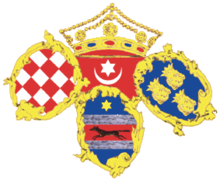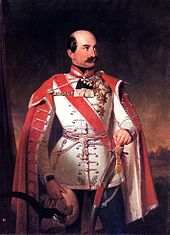| Revision as of 21:45, 5 May 2013 editNewnou (talk | contribs)150 edits rv edit by sock Balkony← Previous edit | Revision as of 00:48, 6 May 2013 edit undoNorden1990 (talk | contribs)Extended confirmed users50,710 edits Undid revision 553686889 by Newnou (talk) reliableNext edit → | ||
| Line 5: | Line 5: | ||
| ==Etymology== | ==Etymology== | ||
| <ref>http://www.britannica.com/EBchecked/topic/51259/ban</ref> | According to Encyclopædia Britannica 2009, Ban is originally a Persian word, ban was introduced into Europe by the ].<ref>http://www.britannica.com/EBchecked/topic/51259/ban</ref> | ||
| The word ''ban'' has entered the English language probably as a borrowing from ] ''ban'', meaning "lord, master; ruler". The Slavic word is probably borrowed from late Thracian ''*ban'' meaning "master (of a house)" (cf. Albanian ''bánë, banésë'' - "house", Romanian ''ban'' - nobility rank, ''Bănie'', ''Banat'' - "region under the rule of ''bans''"),<ref>{{citation |title=Roman and preroman influences in southern slave languages|year=1996|publisher=Evenimentul Publishing House|author=Sorin Paliga|language=romanian|url=http://www.unibuc.ro/uploads_ro/47803/888/Influromanepreromane.pdf}}</ref> that is an old indo-European root ''*pa-'' - "to protect" (see also Persian ''ban'' - "master"). | The word ''ban'' has entered the English language probably as a borrowing from ] ''ban'', meaning "lord, master; ruler". The Slavic word is probably borrowed from late Thracian ''*ban'' meaning "master (of a house)" (cf. Albanian ''bánë, banésë'' - "house", Romanian ''ban'' - nobility rank, ''Bănie'', ''Banat'' - "region under the rule of ''bans''"),<ref>{{citation |title=Roman and preroman influences in southern slave languages|year=1996|publisher=Evenimentul Publishing House|author=Sorin Paliga|language=romanian|url=http://www.unibuc.ro/uploads_ro/47803/888/Influromanepreromane.pdf}}</ref> that is an old indo-European root ''*pa-'' - "to protect" (see also Persian ''ban'' - "master"). | ||
Revision as of 00:48, 6 May 2013

Ban (/ˈbɑːn/) was a title used in several states in central and south-eastern Europe between the 7th century and the 20th century.
Etymology
According to Encyclopædia Britannica 2009, Ban is originally a Persian word, ban was introduced into Europe by the Avars. The word ban has entered the English language probably as a borrowing from South Slavic ban, meaning "lord, master; ruler". The Slavic word is probably borrowed from late Thracian *ban meaning "master (of a house)" (cf. Albanian bánë, banésë - "house", Romanian ban - nobility rank, Bănie, Banat - "region under the rule of bans"), that is an old indo-European root *pa- - "to protect" (see also Persian ban - "master").
Another assumption for the origin of the ban was a borrowing from a Turkic language, from the Avar word bajan meaning "ruler of the horde", a derivation of the Proto-Turkic root *bāj- "rich, noble". The term was also borrowed from a Turkic source into Mongolian, where it is preserved in a basically identical form to this day as bajan "rich".
South Slavic ban (Template:IPA-hr, with a long ) is a result of the contraction from the earlier form bojan. The long form is directly attested in 10th-century Constantine Porphyrogenitus' book De Administrando Imperio as βο(ε)άνος, in a chapter dedicated to Croats and the organisation of their state, describing how their ban "has under his rule Krbava, Lika and Gacka". The 12th-century Byzantine historian John Kinnamos on the other hand already writes the title in its contracted form (μπάνος). Beside South Slavic, the contracted form can be also found in Hungarian bán and Romanian ban.
The word ban can also be found in toponymy, especially in its older possessive form in -jь: Banja Luka, Banj dvor, Banbrdo (from earlier *Banje brdo). The other possessive form in -ov- (banov) is used in modern literary Croatian. Other derivations of the word are present in toponyms such as Banovina, Banat and Banija, and common Croatian surnames such as Ban, Banac, Banić, Banović etc.
Uses of the title
The title was used for local land administrators in the southern Slavonic areas of Croatia and Bosnia in the early Middle Ages, as well as in present-day Serbia (Banate of Macsó). The title was later on also used in the historical Kingdom of Croatia, Kingdom of Bosnia and the Kingdom of Hungary and its dependencies.
The title was used also in Wallachia up to 19th century (where it was associated with the highest boyar office and the region of Oltenia or Severin Banat), medieval Moldavia, the Kingdom of Serbia and Kingdom of Yugoslavia between 1929 and 1941. The meaning of the title changed with time — the position of a ban can be compared to that of a viceroy or a high vassal such as a hereditary duke, but neither is accurate for all historical bans. The territory ruled by a ban was called banat or banovina, often transcribed to English as banate, banat, bannat, etc.
Medieval bans
Ban was the title of local rulers in Croatia and Bosnia since the Slavic population migrated there in the 7th century. References from the earliest periods are scarce, but history recalls the Croatian bans Ratimir in the 9th century (827, under Bulgarian sway) and Pribina in the 10th century (in 949 and in 970). Earliest mentioned Bosnian bans were Borić (1154-1163) and Kulin (1163–1204).
The meaning of the title was elevated to that of provincial governor in the medieval Croatian state (for example, Dmitar Zvonimir was originally a ban in 1065 serving under King Peter Krešimir IV).
Bans were also provincial administrators in the Kingdom of Hungary, where each of the provinces was called banat; the Croatian word for province was banovina. Bans usually administered regions outside the kingdom, but within the realm.
After the Croats elected Hungarian kings as kings of Croatia in 1102, the title of ban acquired the meaning of viceroy because the bans were appointed by the king, though Croatia, remaining a kingdom in personal union with Hungary, was not referred to as a banovina (banate). Croatia was governed by the 'viceregal' ban as a whole between 1102 and 1225, when it was split into two separate banovinas: Slavonia and Croatia. Two different bans were occasionally appointed until 1476, when the institution of a single ban was resumed. The institution of ban in Croatia would persist until the 20th century (see below).
When the medieval Bosnian state achieved a certain level of independence in the 12th century, its rulers were once again called bans, and their territory banovina, likely because of the similar suzerain status that it had towards the king of Hungary. Nevertheless, the Bosnian bans weren't viceroys in the sense they were appointed by the king. Sometimes their title is translated as duke. Kulin came to prominence in Bosnia 1163 as he was under the Byzantine Emperor Manuel I Comnenus who was just taking the country from the Hungarians earlier, although it would not be until 1180 that he would place Kulin as his vassal as Ban.
The rule of Ban Kulin is often remembered as Bosnia's golden age, and he is a common hero of Bosnian national folk tales. Bosnia was autonomous and mostly at peace during his rule. As an ordered and economically prosperous soon became de facto independent state.
The region of Mačva (now in Serbia) was also ruled by bans. Mačva (Macsó) was part of the medieval Hungarian kingdom though under various levels of independence; some of the bans were foreign viceroys, some were native nobles, and one even rose to the status of a royal palatine.
Ban was also the title of the medieval rulers of parts of Wallachia (Oltenia and Severin) since the 13th century. The Wallachian bans were military governors; their jurisdictions in Wallachia were called banat or bănie. The main Wallachian ruler was titled voivod, the position bans aspired to.
Strahinja Banović was a "Ban" of Serb Epic Poetry.
The title ban was also awarded in the Second Bulgarian Empire on several occasions, one example being the 14th-century governor of Sredets (Sofia) Ban Yanuka.
Habsburg-era Croatia
Main article: Ban of Croatia
The title of ban persisted in Croatia after 1527 when the country became part of the Habsburg Monarchy, and continued all the way until 1918. In the 18th century, Croatian bans eventually become chief government officials in Croatia. They were at the head of Ban's Government, effectively the first prime ministers of Croatia.
Kingdom of Yugoslavia
Ban was also the title of the governor of each province (called banovina) of the Kingdom of Yugoslavia between 1929 and 1941. The weight of the title was far less than that of a medieval ban's feudal office.
Legacy
The word ban is preserved in many modern place names in the regions where bans once ruled.
The region of Banat (sometimes called the Temeswarer Banat) in the Pannonian plain between the Danube and the Tisza rivers, now in Romania, Serbia and Hungary, however, received its name without ever being ruled by a ban.
The alternate name of Craiova is Bănie, the residence city of the ban in the medieval Oltenia region.
A region in central Croatia, south of Sisak, is called Banovina or Banija. The origin of the names of Banova Jaruga (a city in Croatia), and Banja Luka and Banovići (cities in Bosnia and Herzegovina) are also from the word ban.
The term ban is still used in the phrase banski dvori ("ban's court") for the buildings that host high government officials. The Banski dvori in Zagreb hosts the Government of Croatia, while the Banski dvor in Banja Luka hosts the President of Republika Srpska (a first-tier subdivision of Bosnia and Herzegovina). The building known as Bela banovina ("the white banovina") in Novi Sad hosts the parliament and government of the Autonomous Province of Vojvodina in Serbia. The building received this name because it previously hosted the administration of Danube Banovina.
See also
- Bans of Croatia
- List of rulers of Bosnia
- Bans of Macsó
- Bans of Danube Banovina
- Ban of Lugoj-Caransebes
- Ban of Severin
- Marzban
- Gespan
References
- http://www.britannica.com/EBchecked/topic/51259/ban
- Sorin Paliga (1996), Roman and preroman influences in southern slave languages (PDF) (in Romanian), Evenimentul Publishing House
- Matasović, Ranko; Jojić, Ljiljana; Anić, Vladimir; Pranjković, Ivo, eds. (2004), Hrvatski enciklopedijski rječnik (in Croatian), vol. 2 (2nd ed.), Zagreb: Jutarnji list, ISBN 953-6045-28-1
- Skok, Petar (1988), Etimologijski rječnik hrvatskoga ili srpskoga jezika (in Croatian), vol. 1, Zagreb: JAZU, pp. 104–105
- "Starostin's STARLING database for Common Turkic, compiled by Anna Dybo". Starling.rinet.ru. Retrieved 2012-04-05.
- DAI 30/90-117, "καὶ ὁ βοάνος αὐτῶν κρατεῖ τὴν Κρίβασαν, τὴν Λίτζαν καὶ τὴν Γουτζησκά"
- Bosnia and Herzegovina -- Britannica Online Encyclopedia Bosnia and Herzegovina: Ancient and medieval periods
- Plamen Pavlov - Car Konstantin II Asen (1397-1422) - posledniyat vladetel na srednovekovna B``lgariya Template:Bg icon
External links
- WorldStatesmen - Croatia, see also each other country above (not completely worked in)
- Ill-formatted IPAc-en transclusions
- Articles with links needing disambiguation from April 2012
- Bans
- Bulgarian noble titles
- Croatian noble titles
- Gubernatorial titles
- Hungarian noble titles
- Noble titles
- Slavic titles
- History of Croatia
- History of Vojvodina
- History of Bosnia and Herzegovina
- History of Romania
- Oltenia
- Hungarian loanwords
- Turkic loanwords
- Slavic loanwords
- Slavic words and phrases
- Titles of national or ethnic leadership
- Viceroys